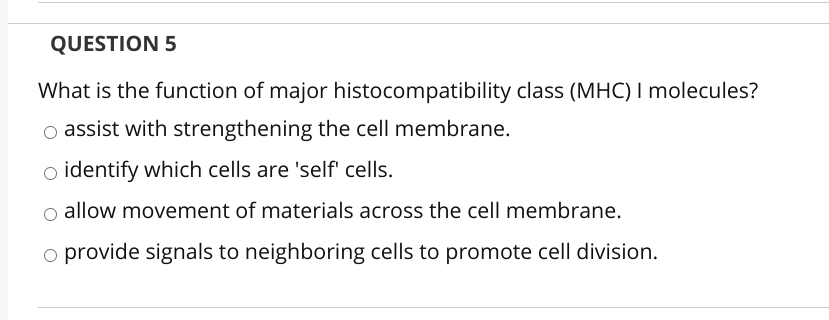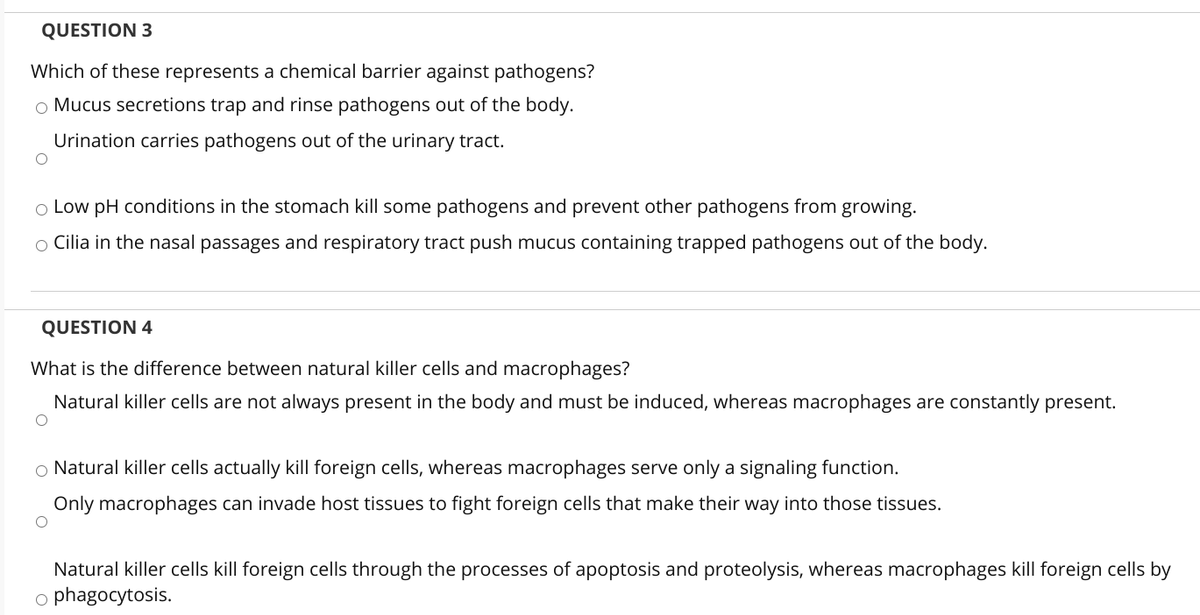QUESTION 5 What is the function of major histocompatibility class (MHC) I molecules? o assist with strengthening the cell membrane. o identify which cells are 'self' cells. o allow movement of materials across the cell membrane. o provide signals to neighboring cells to promote cell division.
QUESTION 5 What is the function of major histocompatibility class (MHC) I molecules? o assist with strengthening the cell membrane. o identify which cells are 'self' cells. o allow movement of materials across the cell membrane. o provide signals to neighboring cells to promote cell division.
Human Anatomy & Physiology (11th Edition)
11th Edition
ISBN:9780134580999
Author:Elaine N. Marieb, Katja N. Hoehn
Publisher:Elaine N. Marieb, Katja N. Hoehn
Chapter1: The Human Body: An Orientation
Section: Chapter Questions
Problem 1RQ: The correct sequence of levels forming the structural hierarchy is A. (a) organ, organ system,...
Related questions
Question
Could you help me with these questions?

Transcribed Image Text:QUESTION 5
What is the function of major histocompatibility class (MHC) I molecules?
o assist with strengthening the cell membrane.
o identify which cells are 'self' cells.
o allow movement of materials across the cell membrane.
o provide signals to neighboring cells to promote cell division.

Transcribed Image Text:QUESTION 3
Which of these represents a chemical barrier against pathogens?
o Mucus secretions trap and rinse pathogens out of the body.
Urination carries pathogens out of the urinary tract.
o Low pH conditions in the stomach kill some pathogens and prevent other pathogens from growing.
o Cilia in the nasal passages and respiratory tract push mucus containing trapped pathogens out of the body.
QUESTION 4
What is the difference between natural killer cells and macrophages?
Natural killer cells are not always present in the body and must be induced, whereas macrophages are constantly present.
o Natural killer cells actually kill foreign cells, whereas macrophages serve only a signaling function.
Only macrophages can invade host tissues to fight foreign cells that make their way into those tissues.
Natural killer cells kill foreign cells through the processes of apoptosis and proteolysis, whereas macrophages kill foreign cells by
o phagocytosis.
Expert Solution
This question has been solved!
Explore an expertly crafted, step-by-step solution for a thorough understanding of key concepts.
Step by step
Solved in 2 steps

Knowledge Booster
Learn more about
Need a deep-dive on the concept behind this application? Look no further. Learn more about this topic, biology and related others by exploring similar questions and additional content below.Recommended textbooks for you

Human Anatomy & Physiology (11th Edition)
Biology
ISBN:
9780134580999
Author:
Elaine N. Marieb, Katja N. Hoehn
Publisher:
PEARSON

Biology 2e
Biology
ISBN:
9781947172517
Author:
Matthew Douglas, Jung Choi, Mary Ann Clark
Publisher:
OpenStax

Anatomy & Physiology
Biology
ISBN:
9781259398629
Author:
McKinley, Michael P., O'loughlin, Valerie Dean, Bidle, Theresa Stouter
Publisher:
Mcgraw Hill Education,

Human Anatomy & Physiology (11th Edition)
Biology
ISBN:
9780134580999
Author:
Elaine N. Marieb, Katja N. Hoehn
Publisher:
PEARSON

Biology 2e
Biology
ISBN:
9781947172517
Author:
Matthew Douglas, Jung Choi, Mary Ann Clark
Publisher:
OpenStax

Anatomy & Physiology
Biology
ISBN:
9781259398629
Author:
McKinley, Michael P., O'loughlin, Valerie Dean, Bidle, Theresa Stouter
Publisher:
Mcgraw Hill Education,

Molecular Biology of the Cell (Sixth Edition)
Biology
ISBN:
9780815344322
Author:
Bruce Alberts, Alexander D. Johnson, Julian Lewis, David Morgan, Martin Raff, Keith Roberts, Peter Walter
Publisher:
W. W. Norton & Company

Laboratory Manual For Human Anatomy & Physiology
Biology
ISBN:
9781260159363
Author:
Martin, Terry R., Prentice-craver, Cynthia
Publisher:
McGraw-Hill Publishing Co.

Inquiry Into Life (16th Edition)
Biology
ISBN:
9781260231700
Author:
Sylvia S. Mader, Michael Windelspecht
Publisher:
McGraw Hill Education